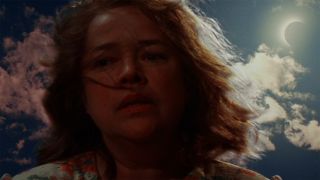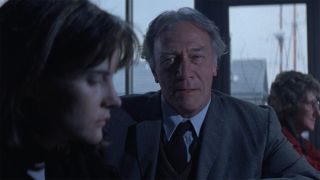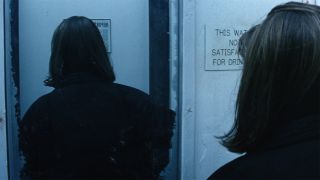Adapting Stephen King's Dolores Claiborne: The 1995 Drama Proves Kathy Bates Isn’t In Enough King Movies
It's time to take a closer look at the adaptation of Dolores Claiborne.

By 1995, Castle Rock Entertainment established a niche market in the world of big screen Stephen King adaptations, a circumstance that fit like a glove given that the company’s name was technically taken from small Maine town that King invented as the setting of books and stories including The Dead Zone and Cujo. Rob Reiner, the director of Stand By Me and co-founder of Castle Rock, clearly formed a connection with the author’s work, and while producing movies like City Slickers, In The Line Of Fire, and Before Sunrise, the company made Reiner’s Misery, Fraser C. Heston’s Needful Things, and Frank Darabont’s The Shawshank Redemption – which became a phenomena upon its release on home video.
The era and collaboration served to change the reputation of Stephen King adaptations, turning heads of those who would ignorantly dismiss the author as a one-trick pony. Obviously nothing would stop the flow of pure horror movies made based on King’s work, like George A. Romero’s The Dark Half and Tobe Hooper’s The Mangler, but new dimensions were added to the perspective of possibilities with the catalogue of novels, novellas, and short-stories. This coincided with a period when the writer himself was undergoing major changes in his personal life – specifically a new dedication to sobriety – and his professional life, as he began to branch out in the kind of stories he would tell.
In that respect, Taylor Hackford’s Dolores Claiborne is a film very much of its time. Based on the book of the same name published in 1992, it’s a movie that certainly has plot developments one categorizes as horrific – featuring subject matter that includes abuse, incest, and murder – but first and foremost it is a character-driven psychological drama with a pair of mysteries at the heart of its story, and no supernatural elements to speak of. Released about five months after The Shawshank Redemption, it has the same level of “prestige,” though it received nowhere near the same level of appreciation.
Is that a fair fate for the film? Given the stellar performances from Kathy Bates, Jennifer Jason Leigh, and Christopher Plummer; the elegant, stylistic approach by Taylor Hackford and cinematographer Gabriel Beristain; and the brilliant screenplay by Tony Gilroy, adapting what seems like an unadaptable book, I would say not. As much appreciation as there is for Dolores Claiborne, there isn’t enough, and the “why” behind that is at the heart of this week’s Adapting Stephen King.

What Dolores Claiborne Is About
Through the first decade-and-a-half of his career, Stephen King almost exclusively wrote books featuring male protagonists. Carrie was his breakout novel, and there is no shortage of well-drawn, complex women characters in the stories, but the overwhelming majority of them feature men as primary subjects. As far as the philosophy of “write what you know” goes, it’s a pretty understandable pattern.
In 1992, however, a less monster-focused Stephen King (having written his monster opus with IT) consciously mixed things up a bit with a literary experiment. That year he published two novels under his contract with Viking Press – both stories featuring a female lead character and life-changing events that take place during the eerie and dangerous light of a total solar eclipse. Gerald’s Game was published in May, and Dolores Claiborne followed six months later in November. And while I’ll get into the former when it comes time to discuss Mike Flanagan’s 2017 adaptation (Read: September 28, 2022), the latter came to be when Stephen King had a “What if” conjuration, as noted in On Writing:
What if a cleaning woman suspected of a murder she got away with (her husband) fell under suspicion for a murder she did not commit (her employer)?
Dolores Claiborne is a book that, technically speaking, only features one location and one “audible” character. This is because it is written in the style of a transcription, with the titular Dolores, a 65-year-old widow living on the fictional Little Tall Island, explaining to the police that she is not responsible for the death of Vera Donovan, the wealthy and dementia-struck woman for whom she has spent decades working as a maid and caregiver. Brash and opinionated, she doesn’t hold back, and while detailing her case and working to prove her innocence, she simultaneously confesses to having murdered her alcoholic and abusive husband, Joe St. George.
CINEMABLEND NEWSLETTER
Your Daily Blend of Entertainment News
Flowing like a monologue and not featuring any structure or breaks, the narrative swings back and forth through time, and ultimately reveals both what really happened to Vera Donovan, and the dark secret Dolores has long been hiding: the one that drove her to kill Joe, and that wound up fracturing her family.

How Taylor Hackford’s Dolores Claiborne Differs From Stephen King’s Book
As you can imagine, Dolores Claiborne makes for an excellent audiobook – with Storm Of The Century/The Mist’s Frances Sternhagen delivering a brilliant reading – but the novel isn’t really one that is built to be turned into a movie. It could be a fascinating one-person theatrical performance as it is written, but as it exists on the page it can’t be directly translated for cinema.
This reality left a young Tony Gilroy with a sincere challenge attempting to adapt the material, the screenwriter at the time having only one other credit (1992’s The Cutting Edge) on his resume. Taking it on, he beautifully demonstrated the ingenuity that would later see him become the successful, Oscar-nominated filmmaker that he is today. He took all of the important plot details from Stephen King’s book, and then repurposed them in a non-linear structure that is bolstered by the enhancement and invention of certain key characters.
The enhanced character in question is Selena St. George, Dolores’ (Kathy Bates) daughter. Her presence in the story as a young girl remains the same (played by Ellen Muth), but everything with her as an adult (played by Jennifer Jason Leigh) is original material created by Tony Gilroy. There is a newspaper clipping featured at the end of the book that identifies Selena as a “famous magazine scribe” who is set to return to Little Tall Island for the first time in 20 years, but that’s after her mother is absolved of any blame in the death of Vera Donovan (Judy Parfitt).
(I should also note that Selena has two brothers in the novel, but she is made to be an only child in the movie).
The prominent character in Dolores Claiborne who doesn’t exist at all in Stephen King’s book is Detective John Mackey (Christopher Plummer), who is introduced as a hard-nosed cop who has long suspected that the titular protagonist killed her husband, but could never prove it. When he learns about the circumstances of Vera Donovan’s death, he’s convinced that it’s a case of a known murderer striking for a second time, and he will go to any length to try and get charges to stick.
The last significant difference I’ll point to between Dolores Claiborne as a book and as a film concerns the death of Joe St. George (David Strathairn). The ploy using the well as a trap while everyone is distracted by the solar eclipse is taken straight from the text, but there are two significant deviations. In Stephen King’s version, Joe doesn’t die instantly, and instead spends a great deal of time at the bottom of the well howling for help. In the hours after his fall, he even manages to nearly climb out, and he attempts to grab at Dolores when he does – but she smashes him in the face with a rock, and the second fall successfully kills him. It’s one of the book’s clearest examples of the author leaning into his horror sensibilities.
The second element of the sequence that’s missing in the movie is the link to Gerald’s Game. In the book, there is a kind of psychic connection that is created during the solar eclipse between Dolores Claiborne and young Jessie Burlingame, the protagonist of the parallel novel who is sexually abused by her father while Dolores is in the process of killing Joe. Taylor Hackford’s adaptation cuts it out (though it’s worth noting that Mike Flanagan’s Gerald’s Game includes its half of the link).

Is It Worthy Of The King?
If one were to play a word association game and put together the names “Stephen King” and “Kathy Bates,” the vast majority of cognizant players would surely note Rob Reiner’s Misery as their first thought… which makes plenty of sense. After all, it was her performance as Annie Wilkes that to this day is the only turn in a King adaptation to earn an Academy Award. Simultaneously, however, it overshadows her awesome cameo in Mick Garris’ The Stand, but more importantly it syphons away attention deserved by Taylor Hackford’s Dolores Claiborne.
The 1995 film certainly feeds on Misery a little, as remembering the terror of Annie “Number One Fan” Wilkes influences how one perceives the opening scene – featuring Dolores “murdering” Vera. What unfolds from there offers a different kind of psychological complexity, though, and Bates’ turn is phenomenal feminist art, perfectly encapsulated in the line, “Sometimes bein' a bitch is all a woman has to hold onto.”
Tony Gilroy’s manipulation of Stephen King’s work gracefully transforms an unfilmable novel into compelling cinema, and Taylor Hackford does equally graceful work bringing Gilroy’s screenplay to life with spectacular artistic touches. Dolores Claiborne is a master class in transitions between past and present in a non-linear story, with Hackford employing different film stocks for the visually contrasting eras, and the director is able to mix in some spectacular stylistic and emotional horror with direct inspiration from surrealist painter René Magritte.
Despite its major and necessary deviations from the source material, Dolores Claiborne is really as great an adaptation as one could make from Stephen King’s book, and it’s hard to imagine any reason for a remake. If anything, it’s a film that could get a fascinating sequel – and that’s actually an idea that Kathy Bates would love to be a part of. She actually told me this personally a few years ago during the press day for Bad Santa 2 when I asked her if there was a particular role she would love to revisit in a sequel:
I don't know that it would be possible to, but probably Dolores Claiborne. That was my favorite movie that I did for a lot of reasons. So I think if I brought... I'd have to talk to Stephen, or I would love to do another Stephen King movie because he writes such wonderful characters.
Stephen King wrote Doctor Sleep more than three-and-a-half decades after The Shining, so I don’t personally see any reason to give up on this idea. And even if it doesn’t happen, at the very least we can keep our fingers crossed that Kathy Bates will be a part of another King adaptation someday, as she hasn’t made one since Dolores Claiborne 26 years ago, and I think that more than qualifies the potential reunion for the label “overdue.”

How To Watch Taylor Hackford’s Dolores Claiborne
Taylor Hackford’s Dolores Claiborne is a title that is sadly not presently available to stream on any of the major subscription services, but beyond that option it is exceptionally easy to find. The Blu-ray, first released by Warner Archive in 2017, is presently in print, and features a whirlwind commentary track with the director (who delivers great insight into the movie while also doing a wonderful job bending over backwards to thank as many people involved with the production as he can). Digital copies of the film are also available for both rental and purchase at all major online outlets, including Amazon, Google, Vudu, and Apple.
Looking ahead, I have to say that I’m particularly excited for next week’s column, as the piece will be taking an in-depth look at Tom Holland’s The Langoliers – an adaptation of one of my favorite science-fiction tales from Stephen King. Look for it in CinemaBlend’s television section on Wednesday, and in the meantime, you can discover previous installments of Adapting Stephen King by clicking through the banners below.







Eric Eisenberg is the Assistant Managing Editor at CinemaBlend. After graduating Boston University and earning a bachelor’s degree in journalism, he took a part-time job as a staff writer for CinemaBlend, and after six months was offered the opportunity to move to Los Angeles and take on a newly created West Coast Editor position. Over a decade later, he's continuing to advance his interests and expertise. In addition to conducting filmmaker interviews and contributing to the news and feature content of the site, Eric also oversees the Movie Reviews section, writes the the weekend box office report (published Sundays), and is the site's resident Stephen King expert. He has two King-related columns.
